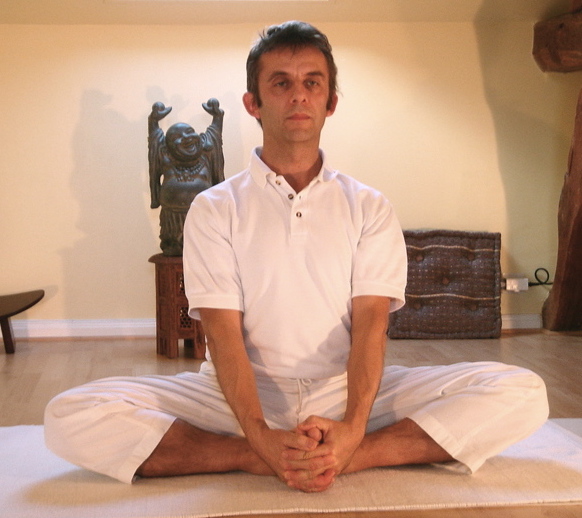Butterfly Pose on:
[Wikipedia]
[Google]
[Amazon]
 Baddha Konasana ( sa, बद्धकोणासन ;
Baddha Konasana ( sa, बद्धकोणासन ;

File:Kashinath asana.jpg, Supta Baddha Konasana, Reclining Cobbler's Pose
File:Mr-yoga-star-pose.jpg, Tarasana, Star Pose
 Baddha Konasana ( sa, बद्धकोणासन ;
Baddha Konasana ( sa, बद्धकोणासन ; IAST
The International Alphabet of Sanskrit Transliteration (IAST) is a transliteration scheme that allows the lossless romanisation of Indic scripts as employed by Sanskrit and related Indic languages. It is based on a scheme that emerged during ...
: ''baddhakoṇāsana''), Bound Angle Pose, Butterfly Pose, or Cobbler's Pose (after the typical sitting
Sitting is a basic action and resting position in which the body weight is supported primarily by the bony ischial tuberosities with the buttocks in contact with the ground or a horizontal surface such as a chair seat, instead of by the lower l ...
position of Indian cobblers when they work), and historically called Bhadrasana, Throne Pose, is a seated asana
An asana is a body posture, originally and still a general term for a sitting meditation pose,Verse 46, chapter II, "Patanjali Yoga sutras" by Swami Prabhavananda, published by the Sri Ramakrishna Math p. 111 and later extended in hatha yoga ...
in hatha yoga
Haṭha yoga is a branch of yoga which uses physical techniques to try to preserve and channel the vital force or energy. The Sanskrit word हठ ''haṭha'' literally means "force", alluding to a system of physical techniques. Some haṭha ...
and modern yoga as exercise
Yoga as exercise is a physical activity consisting mainly of postures, often connected by flowing sequences, sometimes accompanied by breathing exercises, and frequently ending with relaxation lying down or meditation. Yoga in this form has ...
. If the knees rest on the floor, it is suitable as a meditation seat
Meditative postures or meditation seats are the body positions or asanas, usually sitting but also sometimes standing or reclining, used to facilitate meditation. Best known in the Buddhism, Buddhist and Hinduism, Hindu traditions are the Lotus po ...
.
Etymology and origins
The name comes from the Sanskrit words बद्ध, ''Baddha'' meaning "bound", कोण, ''Koṇa'' meaning "angle", and आसन, ''Āsana'' meaning "posture" or "seat". The name Baddha Konasana is relatively recent, but the pose is medieval, as themeditation seat
Meditative postures or meditation seats are the body positions or asanas, usually sitting but also sometimes standing or reclining, used to facilitate meditation. Best known in the Buddhism, Buddhist and Hinduism, Hindu traditions are the Lotus po ...
Bhadrasana (from भद्रा ''Bhadra'', "throne") is described in the 15th century ''Haṭha Yoga Pradīpikā
The ''Haṭha Yoga Pradīpikā'' ( or Light on Hatha Yoga) is a classic fifteenth-century Sanskrit Owners manual, manual on haṭha yoga, written by Svātmārāma, who connects the teaching's lineage to Matsyendranath of the Nathas. It is amon ...
'' 1.53-54.

Description
From sitting position with both the legs outstretched forward, hands by the sides, palms resting on the ground, fingers together pointing forward, the legs are hinged at the knees so the soles of the feet meet. The legs are grasped at the ankles and folded more until the heels reach the perineum. The knees move down to the ground, and with practice reach there; the body is erect and the gaze in front. The asana is held before coming back to the starting position. The thighs are stretched with care. When used for meditation, the hands are placed inAnjali mudra '' (Devanagari: अञ्जली; अंजली) is a Sanskrit word that means " divine offering". It is not only a given name, but also the name given to the greeting between Hindus, Buddhists and other religions on the Indian subcontinent: ha ...
(prayer position) in front of the chest.
The pose strongly opens hip and groin, and is one of the few yoga asanas that can be practiced comfortably soon after eating, except for the forward-bending variation with the head on the floor. It is claimed in ''Light on Yoga
''Light on Yoga: Yoga Dipika'' (Sanskrit: योग दीपिका, "Yoga Dīpikā") is a 1966 book on the Iyengar Yoga style of modern yoga as exercise by B. K. S. Iyengar, first published in English. It describes more than 200 yoga postur ...
'', citing Grantly Dick Reed's ''Childbirth Without Fear'', that the pose is beneficial to pregnant women, as regular practice reduces pain during delivery. If there is a groin or knee injury, the knees must be supported on folded blankets.
Variations
A common variant is Supta Baddha Konasana, Cobbler's Pose in Lying Position, from सुप्त, ''supta'', meaning "supine" or "reclining". Inpregnancy
Pregnancy is the time during which one or more offspring develops ( gestates) inside a woman's uterus (womb). A multiple pregnancy involves more than one offspring, such as with twins.
Pregnancy usually occurs by sexual intercourse, but ca ...
, the pose can be practised reclining as "Wall Butterfly", with the buttocks and feet against a wall, feet together, the knees falling to the sides. The hands can be used to press the knees.
Tarasana, Star Pose, has the body leaning forwards over the clasped feet.
With the thighs supported on folded blankets, 10-pound sandbags may be placed on the inner thigh (near the groin) to assist the stretch.
See also
*List of asanas
An asana is a body posture, used in both medieval hatha yoga and modern yoga. The term is derived from the Sanskrit word for 'seat'. While many of the oldest mentioned asanas are indeed seated postures for meditation, asanas may be standing, sea ...
References
Sources
* * {{DEFAULTSORT:Baddha Konasana Sitting asanas Meditation asanas Medieval Hatha Yoga asanas Hip-opening asanas ru:Растягивающие асаны#Баддха Конасана